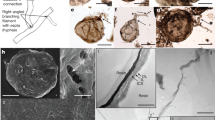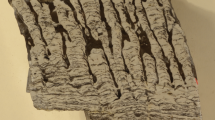Abstract
The paper describes organic remains of one billion years old from the Lakhanda microbiota of the Uchur-Maya Region of southeastern Siberia. The microfossils were discovered on organic sapropelic films. The preserved morphological characters and some developmental stages of the ancient organisms, which are fixed in fossil state, suggest that some of them resembled zygomycetes. Other microfossils under consideration are comparable to reproductive structures of myxomycetes in the type of fusion of spheroid cells and formation of various types of aggregation (sori). Colonies of unicellular microfossils that are arranged in a branching pseudomycelium superficially resemble yeasts. The presence in the same biota of fungal remains belonging to the Myxomycota and Mycota, as well as members of xanthophyte vaucherian algae, indicates that various branches of eukaryotes might have developed in parallel even earlier than the Late Riphean.
Similar content being viewed by others
References
I. P. Borodin, A Brief Review of Mycology (A.N. Petrov, St. Petersburg, 1897) [in Russian].
N. J. Butterfield, “Bangiomorpha pubescens n. gen., n. sp.: Implications for the Evolution of Sex, Multicellularity and the Mesoproterozoic-Neoproterozoic Radiation of Eucaryotes,” Paleobiol. 26, 386–404 (2000).
N. J. Butterfield, “A Vaucheriaceaen Alga from the Middle Neoproterozoic of Spitsbergen: Implications for the Evolution of Proterozoic Eucaryotes and the Cambrian Explosion,” Paleobiol. 30, 231–252 (2004).
N. J. Butterfield, “Probable Proterozoic Fungi,” Paleobiol. 31, 165–182 (2005).
N. J. Butterfield, A. H. Knoll, and K. Swett, “Paleobiology of the Neoproterozoic Svanbergfjellet Formation, Spitsbergen,” Fossils and Strata 34, 1–84 (1994).
A Course of Lower Plants, Ed. by M. V. Gorlenko (Vysshaya Shkola, Moscow, 1981) [in Russian].
Yu. V. Davydov, Riphean Carbonate Deposits of the Southeastern Siberian Platform and Its Surroundings (Composition and Origin) (Nauka, Novosibirsk, 1976) [in Russian].
W. C. Elsik, “Fungal Palynomorphs,” Abstr. J. Paleontol. 56 (Suppl. 2, Part 2) 9 (1982).
T. N. Hermann, “Records of Fungi from the Riphean,” in Paleontology of Precambrian and Early Cambrian (Nauka, Leningrad, 1979), pp. 129–136 [in Russian].
T. N. Hermann, “Filamentous Microorganisms of the Lakhanda Formation on the Mai River,” Paleontol. Zh., No. 2, 126–131 (1981).
T. N. Hermann, Organic World a Billion Years Ago (Nauka, Leningrad, 1990).
T. N. Hermann and V. N. Podkovyrov, “Recovery of Precambrian Microfossils: A Fossil-Saving Technique,” in Methodological Aspects of Palynology (Nauk, Moscow, 2002a) [in Russian].
T. N. Hermann and V. N. Podkovyrov, “On the Finds of Riphean Dimorphic Organisms,” Paleontol. Zh., No. 3, 3–10 (2002b) [Paleontol. J. 36 (3), 231–239 (2002b)].
T. N. Hermann and B. V. Timofeev, “Eosolenides—a New Group of Late Precambrian Problematic Organisms,” in Problematics of the Late Precambrian and Paleozoic (Nauka, Novosibirsk, 1985), pp. 37–40 [in Russian].
A. V. Ivanovskaya, T. N. Hermann, V. N. Podkovyrov, et al., “The Lithology of Clayey Deposits and the Ecology of Microbiotas in the Late Precambrian Lakhanda and Miroedikhino Formations,” in Composition and Properties of Clayey Minerals and Rocks (Nauka, Novosibirsk, 1988), p. 68 [in Russian].
E. J. Javaux, A. H. Knoll, and M. R. Walter, “Morphological and Ecological Complexity in Early Eucaryotic Ecosystems,” Nature 412, 66–69 (2001).
E. J. Javaux, A. H. Knoll, C. P. Marshall, and M. R. Walter, “Recognizing the Geological Signature of Early Life on Earth and Mars,” in Proc. III European Workshop on Exo-Astrobiology. Mars: The Search for Life, Madrid, Spain, November 18–20, 2003 (ESA SPECIES-54, March 2004), pp. 127–130.
L. M. Kursanov, Mycology (Vyssh. Shkola, Moscow, 1953) [in Russian].
V. V. Malakhov, “Major Stages in the Evolution of Eukaryotic Organisms,” Paleontol. Zh., No. 6, 25–32 (2003) [Paleontol. J. 37, 6, 584–591 (2003)].
W. Martin, C. Rotte, M. Hoffmeister, et al., “Early Cell Evolution, Eukaryotes, Anoxia, Sulfide, Oxygen, Fungi First (?), and a Tree of Genomes Revisited,” IUBM Life 55, 193–204 (2003).
S. V. Nuzhnov, Riphean Deposits of the Southeastern Siberian Platform (Nauka, Moscow, 1967) [in Russian].
V. A. Parnes, Anton de Bary (Nauka, Moscow, 1972) [in Russian].
P. A. Popov, “Paleomycology: Its Place, Significance, and Potential for Studying the Organic World of the Precambrian,” in Abstracts of All-Union Symposium on Paleontology of the Precambrian and Early Cambrian (Nauka, Novosibirsk, 1965), pp. 13–15 [in Russian].
S. M. Porter, R. Meisterfeld, and A. H. Knoll, “Vase-Shaped Microfossils from the Neoproterozoic Chuar Group, Grand Canyon: A Classification Guided by Modern Testate Amoebae,” J. Paleontol. 77, 409–429 (2003).
M. A. Semikhatov, “The Refinements of the Isotopic Ages of the Lower Boundaries of the Upper Riphean, Vendian, Upper Vendian, and Lower Cambrian,” in Supplements to the Stratigraphic Codex of Russia (Vseross. Geol. Inst., St. Petersburg, 2000), pp. 95–107 [in Russian].
M. A. Semikhatov and S. N. Serebryakov, Siberian Hypostratotype of the Riphean (Nauka, Moscow, 1983) [in Russian].
Ya. I. Starobogatov, “On the Number of Kingdoms of Eukaryotic Organisms,” in The Systematics of Protists and Their Phylogenetic Relationships with the Lower Eukaryotes (Nauka, Leningrad, 1986), pp. 4–24 [in Russian].
B. V. Timofeev and T. N. Hermann, “The Lakhanda Microbiota of the Mai River,” in Paleontology of the Precambrian and Early Cambrian (Nauka, Leningrad, 1979), pp. 137–147 [in Russian].
Yin Lei-ming, “Acanthomorphic Acritarchs from Meso-Neoproterozoic Shales of the Ruyang Group, Shanxi, China,” Rev. Paleobot. Palynol. 98, 15–25 (1997).
Author information
Authors and Affiliations
Additional information
Original Russian Text © T.N. Hermann, V.N. Podkovyrov, 2006, published in Paleontologicheskii Zhurnal, 2006, No. 2, pp. 89–95.
Rights and permissions
About this article
Cite this article
Hermann, T.N., Podkovyrov, V.N. Fungal remains from the Late Riphean. Paleontol. J. 40, 207–214 (2006). https://doi.org/10.1134/S0031030106020122
Received:
Issue Date:
DOI: https://doi.org/10.1134/S0031030106020122




